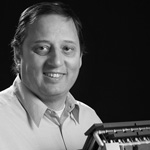A ship in a bottle
Marzio Nessi has been active in collider physics at CERN since 1989, starting in the UA2 experiment. He has been involved with the ATLAS experiment from the beginning, and is presently the ATLAS Technical Co-ordinator.
 “We have plenty of evidence that the discoveries to be made at the LHC could dramatically change our ideas, not only about the basic components of matter but maybe about the whole of nature. Since the early 1990s, we in ATLAS have been dreaming, designing, prototyping, and are now constructing, testing and installing a detector equal to the challenge. From the start, it was clear that our task would not be easy; the scale of the enterprise is ten times greater than anything our scientific community has mastered in the past.
“We have plenty of evidence that the discoveries to be made at the LHC could dramatically change our ideas, not only about the basic components of matter but maybe about the whole of nature. Since the early 1990s, we in ATLAS have been dreaming, designing, prototyping, and are now constructing, testing and installing a detector equal to the challenge. From the start, it was clear that our task would not be easy; the scale of the enterprise is ten times greater than anything our scientific community has mastered in the past.
The ATLAS collaboration evolved during the early 1990s and in 1996, given the green light by CERN Council, construction of the detector started. We make up one of the strongest scientific collaborations ever formed, bringing together more than 1700 scientists from 150 universities and national laboratories in more than 34 countries. Much of the equipment is being constructed in laboratories far-flung around the world, from Brazil to Japan, and brought to CERN for final assembly.
The ATLAS detector is designed to be fast, precise, hermetic and capable of running for a decade without major interventions. It is impressively large and complex, 47 metres long, 25 metres in diameter, weighing 7 000 tons. When surrounded by its ‘life support system', it will be a tight squeeze to fit it into the 55mx30mx30m underground cavern. As the ATLAS Technical Co-ordinator, it is my personal challenge to organize this effort and to see it safely through to a timely completion.
The construction of ATLAS is well advanced and installation began in June 2003. Like putting a ship in a bottle, lowering and assembling the detector pieces underground is a complicated and delicate job that is proceeding at full speed. Every day, an average of 40 - 50 groups and firms are present on the construction site. Despite the often mutually incomprehensible language mix, from Chinese to Armenian, hundreds of people are working together in a tangibly co-operative spirit. This is a real tribute to international hand signals plus a terrific amount of enthusiasm, and the excitement is non-stop. Before our very eyes, what began as a virtual reality movie is being transformed into a huge apparatus for particle physics in the decade ahead. The job will be finished in winter 2006, when ATLAS will be fully installed, ready to receive particle beams the following spring and to discover the new physics lying beyond the present high energy frontier.”

